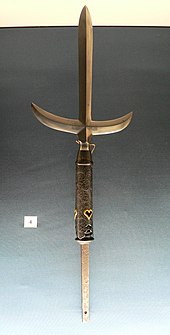Radical 79
| 殳 | ||
|---|---|---|
| 78 ⽍ ◄ | 79 | ► ⽏ 80 |
| Pinyin : | shū (= halberd, lance) | |
| Zhuyin : | ㄕ ㄨ | |
| Hiragana : | ほ こ づ く り hokozukuri | |
| Kanji : | ル 又, 殳 旁rumata, hokozukuri | |
| Hangul : | 칠 수 몽둥이 | |
| Sinocorean : | 수 | |
| Codepoint : | U + 6BB3 |
|
| Stroke sequence : |
|
|
Radical 79 , meaning “ halberd , lance ”, is one of the 34 traditional radicals in Chinese writing , which consist of four strokes.
With 16 combinations of characters in Mathews' Chinese-English Dictionary , it is very rare in the dictionary.
This old bamboo weapon became a work tool with a curved handle that was used to carry loads. As a single character, 殳 was only used very rarely, and it soon mutated into a radical . It is hardly known with its pronunciation shū. To describe it, the designation of its two more well-known components 又 (you) and 几 (ji) is used: 几 又 边 (jiyou bian = jiyou side part).
殳 always stands on the right in the compound symbol: 殴 (= hit), 殷 (= dark red) and, as a bearer of meaning, creates the meaning field of hand movement with a device as in 投 (= throw, hurl), 役 (= work, service, with the components彳 chì for movement and 殳 shū, the hand with the weapon). The real meaning of 役 is therefore: battle, campaign.
Character combinations ruled by radical 79
| Strokes | character |
|---|---|
| + 0 | 殳
|
| + 5 | 殴 段 殶
|
| + 6 | 殷 殸 殹 殺
|
| + 7 | 殻
|
| + 8 | 殼 殽
|
| + 9 | 殾 殿 毀 毁 毂
|
| +10 | 毃 毄
|
| +11 | 毅 毆
|
| +12 | 毇 毈
|
| +15 | 毉
|
| +19 | 毊 |
In the Unicode block Kangxi radicals , radical 79 is coded under the code point number 12.110 (U + 2F4E).
literature
- Edoardo Fazzioli : Painted Words. 214 Chinese characters - from picture to concept . Marixverlag, Wiesbaden 2004, ISBN 3-937715-34-7 , p. 133 .
- For detailed references, see List of Traditional Radicals: Literature
Web links
- Xiù cai.oai.de (PDF; 1.72 MB) Explanation of Radikal 79 on page 85

